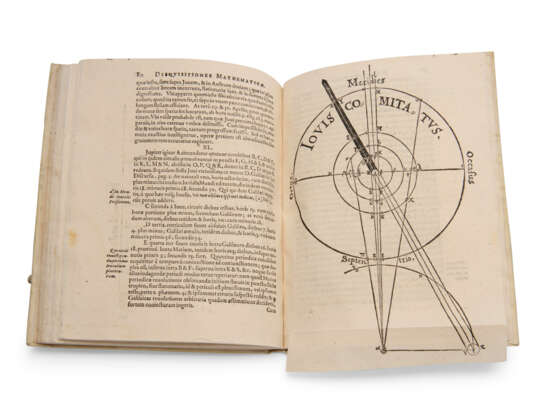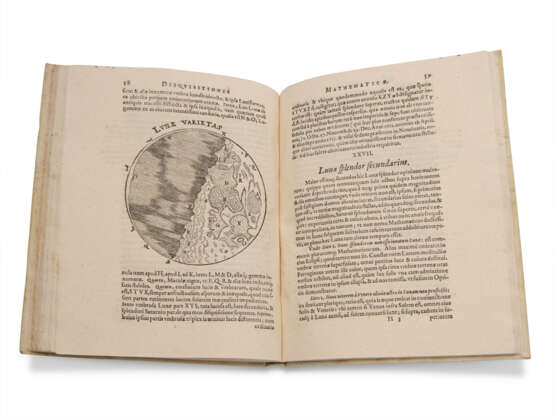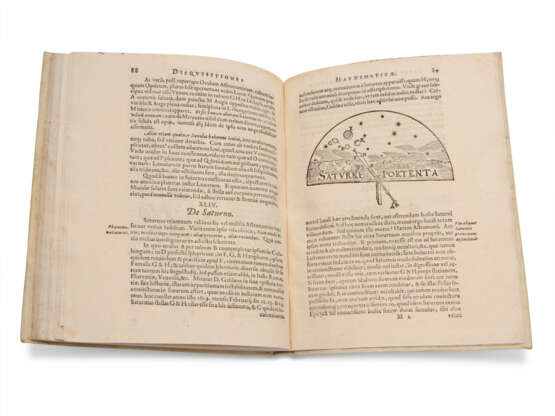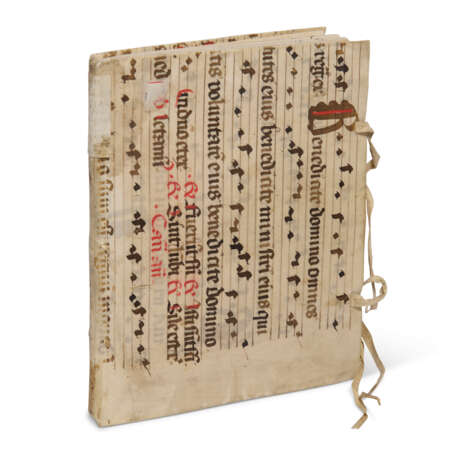ID 1449859
Lot 92 | SCHEINER, Christoph (ca 1579-1650)
Estimate value
£ 10 000 – 15 000
Disquisitiones mathematicae, de controversiis et novitatibus astronomicis. Quas publice disputandas posuit, propugnavit. Ingolstadt: Wolfgang Eder for Elisabeth Angermaier, 1614. [Bound after:] TANNER, Adam (1572-1632). Astrologia Sacra: Hoc est, Orationes Et Qvaestiones Qvinqve, Qvibvs Explicatvr, An Et Qva Ratione Fas Sit Homini Christiano, de rebus occultis, praesertim futuris, ex astris iudicium ferre. Ingolstadt: Wolfgang Eder for Elisabeth Angermaier, 1615.
Rare first edition, featuring the first practical illustration of the telescope and one of the earliest maps of the moon. It treats many of the contemporary astronomical debates, being a treatise born from the public disputations Scheiner organised at the University of Ingolstadt as professor of mathematics and Hebrew. It discusses the moon, sunspots, the moons of Jupiter, Saturn, the systems of Copernicus and Tycho Brahe, optics and the phases of Venus, along with observations made using the newly-invented telescope by both Scheiner and Galileo, with whom he had engaged in a bruising public debate on sunspots three years earlier. Disquisitiones mathematicae contains the first illustration of the telescope in use: the observation of Saturn and the phases of Venus are shown on pp. 87 and 89 respectively. It also contains the second earliest map of the moon made from independent observation, following Galileo’s Sidereus Nuncius of 1610: a topographical map of the moon appears on p.58, with craters and other features labelled and listed, in contrast to the schematic views produced by Galileo in 1610 (Kopal, ‘The earliest maps of the moon’, p. 62). Scheiner is bound after a treatise on astronomy by his Jesuit Superior and colleague at Ingolstadt, Adam Tanner, on the usefulness of telescopic observations, the relation of theology to astrology and to astronomy, and a discussion of Galileo’s discoveries announced in Sidereus Nuncius. Rare: only one other copy at auction in almost half a century, according to RBH (Streeter copy; Christie’s, 16 April 2007, lot 460). Houzeau & Lancaster 2948; BM/STC 17th-century German S-594.
Quarto (195 x 154 mm). Numerous woodcut illustrations and diagrams in text, some full page, two slightly extending over the margin and folded on one side (small dent at top corner of earlier pages with a little damage to title, 12mm tear to margin of p.13, slight loss to fore-edge of p.15). Contemporary binding re-using a noted vellum leaf from a German music manuscript with hufnagel notation, preserving original ties, old paper label (good condition, but for some light staining and rubbing and a small loss to one tie). Provenance: erased ownership inscription on Tanner title.
| Place of origin: | Western Europe, Germany, Europe |
|---|---|
| Auction house category: | Books and manuscripts, Printed books |
| Place of origin: | Western Europe, Germany, Europe |
|---|---|
| Auction house category: | Books and manuscripts, Printed books |
| Address of auction |
CHRISTIE'S 8 King Street, St. James's SW1Y 6QT London United Kingdom | |
|---|---|---|
| Preview |
| |
| Phone | +44 (0)20 7839 9060 | |
| Buyer Premium | see on Website | |
| Conditions of purchase | Conditions of purchase |






